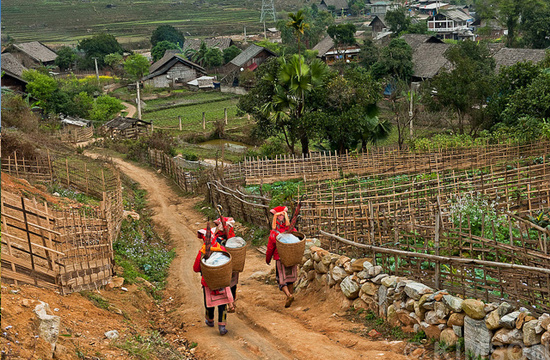Ban Ho or Ho Village or Ban Ho Village is one of the most important and interesting tourism spots in Sapa, Vietnam.
If your trip is to Sapa to explore its stunning ethnic villages, Ban Ho is definitely a must-go. Located at 30 km distance from Sapa center to the southwest, this village is home of ethnics including the Mong, Dao, Tay, Dzay and Nung living. Because the weather here is warmer and more comfortable comparing to other areas in Sapa, Ban Ho is always recommended for year-round trips. Tourists to this place can never resist praising for the charming nature, pristinely long-standing customs and since the locals are completely friendly and hospitable, you may get an invitation to a meal in their homes or participate in their routines to explore the very ethnic life in Sapa.
If you are in Sapa, do not drive or ride to Ban Ho but trek to explore the pristinely stunning beauty of the nature here. You should spend time in its mighty terraced fields then scattered stilted houses with typical construction along with winding pure and magnetic streams of Muong Hoa and Lavie as well as May Bridge. These are obviously worth a visit and besides, you are recommended managing your trek to go with superb waterfalls and many other stunning cultural features. Though it is beautiful, the winding and adventurous pass paths may challenge you with some difficulties; however, it is also an worth experience when reaching to the village in such paths if you are risky and energetic. While you are Ban Ho on occasions, you can take part in awesome local festivals like “Xuong dong” festival and come and join in fascinating activities with the local, for example, Sap dancing and Xoe dancing.
Ban Ho center is Ban Den hamlet, where Muong Hoa and Lavie meet together. It also remains a legendary love story about these streams that the locals are always willing to tell you. Coming to Ban Ho, you almost witness the most pristine ever images of traditional stilted houses scattered on along the streams and hill sides. It is recommended coming in group or with family so that you can enjoy the warm and cosy atmosphere with the local when homestaying. Homestaying in Ban Den is very nice with 29 biggest and most beautiful houses in the hamlet. In morning, it is time to visit Hoang Lien Son National Park to explore the various species of plants and animals. The weather in Ban Ho is usually better and warmer than in others, ranging from 18 to 25 Centigrade, so you should spend time discovering dreamy Lavie Stream and watching breathtaking Ca Nhay Waterfalls. Companying with Muong Hoa Stream, Lavie Stream is one of the two main sources of water playing significant parts in the local life. Winding over forests, hills and mountains and mighty terraced fields of the Tay’s village nestled in the marvelous Muong Hoa Valley, it looks like a charming symbol of Ban Ho Sapa. In addition, swimming in the fresh and clean Lavie is an unforgettable experience and when you trip to the northern town of Vietnam in summer, Lavie is a must. Differing from Muong Hoa Stream supplying with water to tens of villages that it runs over daily, Lavie Stream flows to Ban Den from the high mountains and virgin forests, so it seems to be more fascinating, mysterious and clearer. Besides Muong Hoa Stream and Lavie Stream, Ban Den’s surroundings are also worth a visit such as Ca Nhay Waterfalls, Silver Waterfalls, Love Waterfalls, Seo Trung Ho Waterfalls, in which Seo Trung Ho from the height of more than a hundred meters, travelers can catch the image of the waterfalls like a natural white silky band crossing the mountain half side.
The tourists coming here always remember the appealing natural landscapes, reserved customs and the hospitality of the locals. Thus why don’t you pack your backpack then trip to Ban Ho – Sapa?
Information
– Distance from Sapa center: 30km to the southeast
– Ethnics: the Mong, Dao, Tay, Dzay and Nung, mainly the Tay
– Attractions: May Bridge, Ca Nhay Waterfalls, Silver Waterfalls, Love Waterfalls, Seo Trung Ho Waterfalls, Hoang Lien Son National Park and ethnic traditions


